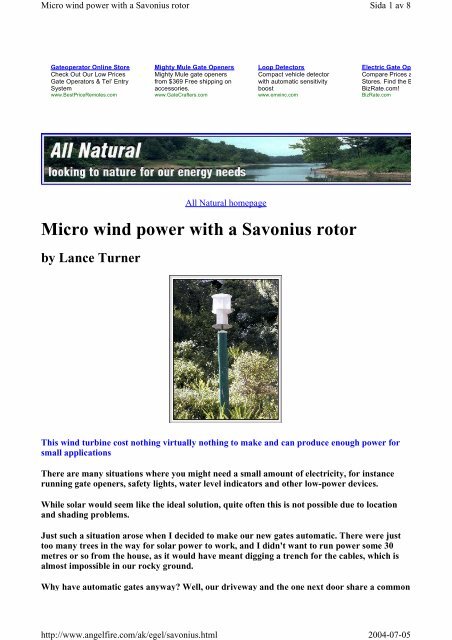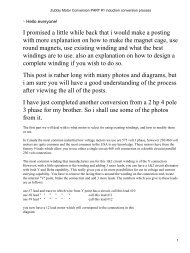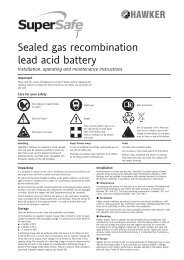Micro wind power with a Savonius rotor - Otherpower
Micro wind power with a Savonius rotor - Otherpower
Micro wind power with a Savonius rotor - Otherpower
Create successful ePaper yourself
Turn your PDF publications into a flip-book with our unique Google optimized e-Paper software.
<strong>Micro</strong> <strong>wind</strong> <strong>power</strong> <strong>with</strong> a <strong>Savonius</strong> <strong>rotor</strong><br />
http://www.angelfire.com/ak/egel/savonius.html<br />
Sida 1 av 8<br />
2004-07-05<br />
Gateoperator Online Store<br />
Check Out Our Low Prices<br />
Gate Operators & Tel’ Entry<br />
System<br />
www.BestPriceRemotes.com<br />
Mighty Mule Gate Openers<br />
Mighty Mule gate openers<br />
from $369 Free shipping on<br />
accessories.<br />
www.GateCrafters.com<br />
Loop Detectors<br />
Compact vehicle detector<br />
<strong>with</strong> automatic sensitivity<br />
boost<br />
www.emxinc.com<br />
Electric Gate Op<br />
Compare Prices a<br />
Stores. Find the B<br />
BizRate.com!<br />
BizRate.com<br />
All Natural homepage<br />
<strong>Micro</strong> <strong>wind</strong> <strong>power</strong> <strong>with</strong> a <strong>Savonius</strong> <strong>rotor</strong><br />
by Lance Turner<br />
This <strong>wind</strong> turbine cost nothing virtually nothing to make and can produce enough <strong>power</strong> for<br />
small applications<br />
There are many situations where you might need a small amount of electricity, for instance<br />
running gate openers, safety lights, water level indicators and other low-<strong>power</strong> devices.<br />
While solar would seem like the ideal solution, quite often this is not possible due to location<br />
and shading problems.<br />
Just such a situation arose when I decided to make our new gates automatic. There were just<br />
too many trees in the way for solar <strong>power</strong> to work, and I didn't want to run <strong>power</strong> some 30<br />
metres or so from the house, as it would have meant digging a trench for the cables, which is<br />
almost impossible in our rocky ground.<br />
Why have automatic gates anyway? Well, our driveway and the one next door share a common
<strong>Micro</strong> <strong>wind</strong> <strong>power</strong> <strong>with</strong> a <strong>Savonius</strong> <strong>rotor</strong><br />
http://www.angelfire.com/ak/egel/savonius.html<br />
Sida 2 av 8<br />
2004-07-05<br />
entrance, so to open the gates we have to block their driveway Also, the driveways are very<br />
steep, and starting off driving up from a standstill is not too good for the vehicle's clutch.<br />
Besides, when an opportunity arises to install some form of new renewable energy device, how<br />
can I say no?<br />
Anyway I decided to provide <strong>power</strong> to the electric gate openers from a small <strong>wind</strong> turbine.<br />
While we don't have many <strong>wind</strong>y days, we do have one or two each fortnight where the <strong>wind</strong><br />
blasts through for at least 24 hours solid, so I guessed that I should be able to <strong>power</strong> a device<br />
<strong>with</strong> such modest <strong>power</strong> requirements as a gate opener in this way<br />
The gate opener system itself is a home made job, using car <strong>wind</strong>screen wiper motors driving<br />
long brass threaded shafts.These run through a nut which is attached to the gate via a steel<br />
tube, bolt and two metal brackets.<br />
The motors are hinged, and when they are run they either push the nut away from them or<br />
pull it toward them, thus opening and closing the gates.<br />
The control circuit for this kit purchased from Qatley Electronics in Sydney and includes a<br />
courtesy light function, remote motors are hinged, and when they are control, and motor<br />
current sensing.<br />
Too much turbulence<br />
I briefly thought about what type of turbine I could install and how it would look.<br />
Safety was another factor, having curious children who can climb just about anything. For<br />
these reasons I decided against buying a small horizontal axis turbine, they are too dangerous -<br />
when close to the ground and in touching distance, so I decided to install a <strong>Savonius</strong> <strong>rotor</strong><br />
instead.<br />
This type of vertical axis <strong>rotor</strong> is very robust and durable if built correctly, is relatively slow<br />
turning and can be easily built at home, <strong>with</strong>out the hassles of aerofoil blade design and other<br />
problems associated <strong>with</strong> horizontal axis 'propeller' type turbines.<br />
What's more, unlike a horizontal axis turbine, a <strong>Savonius</strong> is always facing the <strong>wind</strong>, and more<br />
importantly for this site, is not badly affected by turbulence, which is quite high where the<br />
turbine had to be located.<br />
As can be seen from the photo, the turbine is mounted quite low due to it being on a residential<br />
block. While this is far from optimal, it should provide enough <strong>power</strong> for the gate openers<br />
providing it is used <strong>with</strong> a battery of relatively high capacity.<br />
Making the turbine<br />
The turbine was made from three disks of 1.2mm aluminium sheet 330mm in diameter and a<br />
length of 150mm diameter stormwater pipe about 600mm long.<br />
This was cut in half in both directions, across and lengthways, to provide four vanes for the<br />
turbine. These vanes were then assembled between the three disks as shown in the photo. Small<br />
aluminium angle brackets and stainless steel pop rivets were used to hold it all together.
<strong>Micro</strong> <strong>wind</strong> <strong>power</strong> <strong>with</strong> a <strong>Savonius</strong> <strong>rotor</strong><br />
http://www.angelfire.com/ak/egel/savonius.html<br />
Sida 3 av 8<br />
2004-07-05<br />
Here you can see the whole motor and <strong>rotor</strong> assembly before fitting to the mast and painting.<br />
Note how the vanes in the top section are rotated 90° to those in the bottom section and the<br />
motor does not yet have the plastic angle sections attached.<br />
The two vanes in the top section of the <strong>rotor</strong> are rotated 90 degrees to the bottom ones. This<br />
ensures that there is always at least one vane in a position to catch the <strong>wind</strong>, so the turbine is<br />
self-starting.<br />
The axle for the <strong>rotor</strong> was a length of 40mm diameter water pipe.<br />
This runs straight through the centre of all three disks, and the inner edge of each of the <strong>rotor</strong><br />
vanes are riveted to it.<br />
In the bottom end of the axle I pressed in (read hammered) an aluminium adapter bushing to<br />
allow the turbine to be connected directly to a generator.<br />
The final assembly was very strong and rigid and was surprisingly well balanced<br />
While a central axle shaft is not considered optimal design for a <strong>Savonius</strong> <strong>rotor</strong>, it does have<br />
advantages, such as increasing turbine strength and allowing easy alignment in multi-stage<br />
<strong>rotor</strong>s.<br />
<strong>Savonius</strong> design<br />
There are several variations of <strong>Savonius</strong> <strong>rotor</strong> that I have seen, all of which work well. The<br />
efficiency of a <strong>Savonius</strong> is only around 15 per cent but they are ideal for many situations. Some<br />
variations are shown below, looking down from the top of the turbine.<br />
This is the design I use. it is very strong due to the central shaft, but slightly less efficient than<br />
the other two. However, the extra strength allows the <strong>rotor</strong> to be supported at one end only.
<strong>Micro</strong> <strong>wind</strong> <strong>power</strong> <strong>with</strong> a <strong>Savonius</strong> <strong>rotor</strong><br />
http://www.angelfire.com/ak/egel/savonius.html<br />
Sida 4 av 8<br />
2004-07-05<br />
This design is also very simple, and can also be made easily from metal drums or pipe sections.<br />
The design is slightly more efficient than the one above as some of the air is deflected by the<br />
second vane as it exits the first one.<br />
This is the most efficient <strong>Savonius</strong> design. It not only has the advantage of air being deflected<br />
twice like the design above, but also that the vanes act partly like an airfoil when they are edgeon<br />
into the <strong>wind</strong>, creating a small lift effect and thus enhancing efficiency. This design is much<br />
more difficult to build. requiring vanes rolled from metal sheet instead of being cut from<br />
drums or pipes.<br />
Generating the <strong>power</strong><br />
The generator I used was actually a large permanent magnet DC motor from an old vertical<br />
computer tape drive.<br />
These are very robust, well built motors about the size of a large car starter motor. They are<br />
simple and reliable, and as generators are extremely efficient-connecting one to a torch bulb<br />
causes the bulb to be blown by a quick flick of the shaft!<br />
The <strong>rotor</strong> slides directly onto the end of the motor shaft, and is held in place <strong>with</strong> a stainless<br />
steel bolt.<br />
In this design, I decided to see if I could do away <strong>with</strong> having a top bearing. The bearings in<br />
the tape drive motor are at least as strong as the average car alternator bearing, and the local<br />
bearing shop gave me specs that indicate that most bearings this size will take a radial load<br />
(the load the <strong>wind</strong> would place on the bearing) of up to 450kg, and an axial load (the load from<br />
the <strong>rotor</strong>'s weight) of up to 45kg.<br />
This was heaps for my uses, so I decided to leave out the top bearing and see how the turbine<br />
went.<br />
The mast<br />
This was made from a 2200mm length of 150mm diameter PVC water pipe, just like the <strong>rotor</strong>.<br />
In sections this diameter and this length, PVC pipe is quite rigid.<br />
The pipe was buried about 400mm into a hole and concreted into place.<br />
The mast does still flex a bit in a strong <strong>wind</strong> and if this proves to be a
<strong>Micro</strong> <strong>wind</strong> <strong>power</strong> <strong>with</strong> a <strong>Savonius</strong> <strong>rotor</strong><br />
http://www.angelfire.com/ak/egel/savonius.html<br />
Sida 5 av 8<br />
2004-07-05<br />
Problem it can easily be made rigid by filling <strong>with</strong> concrete.<br />
The generator is mounted to the top of the pole by means of a stormwater pipe endcap.<br />
The DC motor fitted to the plastic end cap which holds it to the mast<br />
The face of the generator has four screw holes, so it was just a matter of drilling corresponding<br />
holes into the end cap, and one much larger hole in the centre for the shaft.<br />
Front view of the motor note the threaded holes in the face plate<br />
This rear view shows the three plastic angle sections used to make the motor a tight fit in the
<strong>Micro</strong> <strong>wind</strong> <strong>power</strong> <strong>with</strong> a <strong>Savonius</strong> <strong>rotor</strong><br />
http://www.angelfire.com/ak/egel/savonius.html<br />
Sida 6 av 8<br />
2004-07-05<br />
mast<br />
By itself, this would not have been strong enough, as the end cap would have flexed and<br />
eventually broken through, so I attached three short braces made from 25 x 25 x 3 plastic angle<br />
to the other end of the generator.<br />
These were fixed to the motor using machine screws into the bottom end plate, and point out<br />
away from the centre of the generator. The overall diameter of the circle they make is the same<br />
as that of the inside of the pipe, so that when the generator is slid into the pipe the whole<br />
assembly is quite solid.<br />
Hopefully this will be all that is required, but I suspect that the end cap may still not be quite<br />
strong enough, so I might have to replace it <strong>with</strong> a metal equivalent further down the track.<br />
The step up converter built from a kit. It starts from just four volts snd outputs s regulated 14<br />
volts to the battery<br />
Voltage matching<br />
The output voltage of the generator is actually quite low at the speeds it is likely to turn at<br />
attached to a <strong>Savonius</strong> <strong>rotor</strong>. At 200 RPM the output is only about four or five volts.<br />
While this is obviously not enough to charge a 12 volt battery by itself, a bit of clever circuitry<br />
solved the problem.<br />
Some time back a circuit was published in one of the electronics magazines that allowed a 12<br />
volt battery to be charged from another.<br />
This was used for charging small sealed-lead acid batteries from a car battery, and involved a<br />
switchmode step-up circuit to provide a regulated 13.8 volts or so from 12 volts from the car<br />
battery.<br />
I have built several of these from various suppliers, and they work quite well.<br />
The one I used I already had from another disused project, so I tested it and found that it<br />
would output the required 13.8 volts from as little as four volts in.<br />
This kit was originally bought from Jaycar Electronics, who no longer sell it, but they do have<br />
a pre-built module called a solar <strong>power</strong> converter, cat# AA0259, that will take an input voltage<br />
from one to ten volts and charge a 12 volt battery-perfect for uses such as this.<br />
The unit seemed ideal for my turbine so I connected it to the generator and tested it. At under
<strong>Micro</strong> <strong>wind</strong> <strong>power</strong> <strong>with</strong> a <strong>Savonius</strong> <strong>rotor</strong><br />
http://www.angelfire.com/ak/egel/savonius.html<br />
Sida 7 av 8<br />
2004-07-05<br />
200 RPM I was getting full charging voltage, <strong>with</strong> available current increasing as <strong>rotor</strong> speed<br />
increased.<br />
Final assembly<br />
The circuit was housed in a box and slid down inside the tube before the generator and end cap<br />
were fitted. The cables from the output of the circuit run down inside the mast and out of a<br />
sealed hole at the bottom, through some flexible conduit to the box containing the gate opener<br />
circuitry.<br />
The mast and turbine were both painted green to help them blend in <strong>with</strong> their surroundings.<br />
The photos show the turbine before its paint job.<br />
To prevent water getting into the generator bearing, a skirt will be attached around the<br />
perimeter of the bottom of the turbine.<br />
Costs<br />
The turbine was very cheap to build, the most expensive part being the second hand tape drive<br />
motor which cost $25. The voltage conversion kit cost $24 a couple of years back, and the rest<br />
of the material was free.<br />
The water pipe was salvaged second-hand from a building site, while the aluminium sheet was<br />
from some old signs I found in my workshop after we moved in.<br />
The only other expenses were a dollar or two worth of paint and rivets and $5 for a bag of<br />
concrete.<br />
This article originally appeared in The Jan March 2000 issue of the<br />
email the ReNew magazine<br />
Cheers<br />
Subscribe to energy2000<br />
enter email address<br />
Powered by groups.yahoo.com<br />
Our entire web contents main Links Directory
<strong>Micro</strong> <strong>wind</strong> <strong>power</strong> <strong>with</strong> a <strong>Savonius</strong> <strong>rotor</strong><br />
http://www.angelfire.com/ak/egel/savonius.html<br />
Sida 8 av 8<br />
2004-07-05<br />
Goto.com:<br />
Search made<br />
Simple





